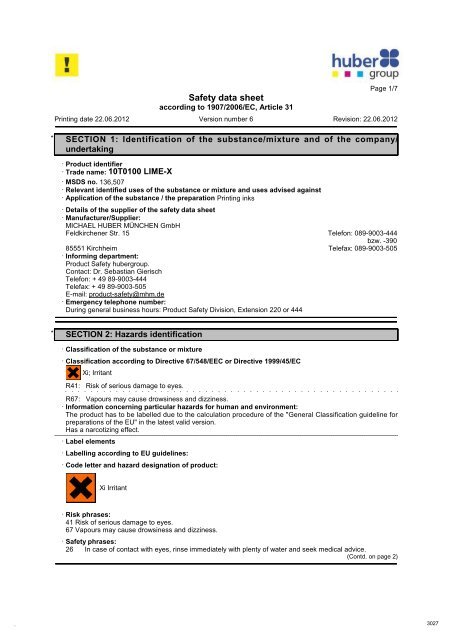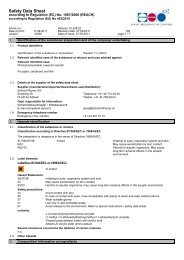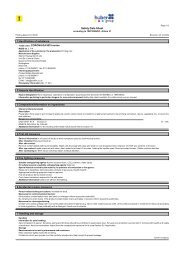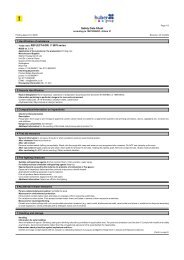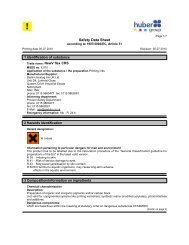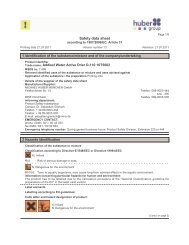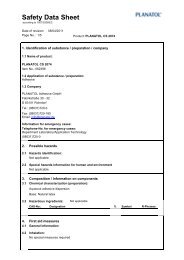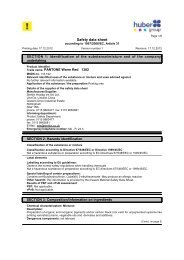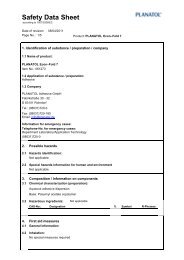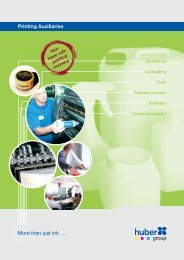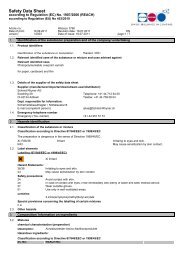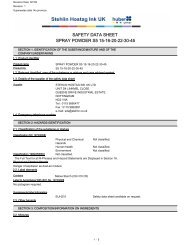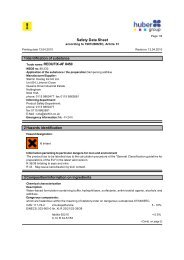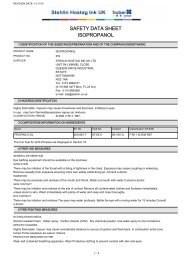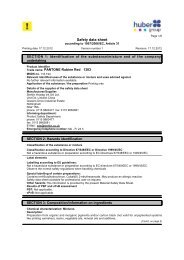Lime-X 10T7265 - Stehlin Hostag UK
Lime-X 10T7265 - Stehlin Hostag UK
Lime-X 10T7265 - Stehlin Hostag UK
You also want an ePaper? Increase the reach of your titles
YUMPU automatically turns print PDFs into web optimized ePapers that Google loves.
34.0.12<br />
Safety data sheet<br />
according to 1907/2006/EC, Article 31<br />
Page 1/7<br />
Printing date 22.06.2012 Version number 6<br />
Revision: 22.06.2012<br />
* SECTION 1: Identification of the substance/mixture and of the company/<br />
undertaking<br />
· Product identifier<br />
· Trade name: 10T0100 LIME-X<br />
· MSDS no. 136,507<br />
· Relevant identified uses of the substance or mixture and uses advised against<br />
· Application of the substance / the preparation Printing inks<br />
· Details of the supplier of the safety data sheet<br />
· Manufacturer/Supplier:<br />
MICHAEL HUBER MÜNCHEN GmbH<br />
Feldkirchener Str. 15 Telefon: 089-9003-444<br />
bzw. -390<br />
85551 Kirchheim Telefax: 089-9003-505<br />
· Informing department:<br />
Product Safety hubergroup.<br />
Contact: Dr. Sebastian Gierisch<br />
Telefon: + 49 89-9003-444<br />
Telefax: + 49 89-9003-505<br />
E-mail: product-safety@mhm.de<br />
· Emergency telephone number:<br />
During general business hours: Product Safety Division, Extension 220 or 444<br />
* SECTION 2: Hazards identification<br />
· Classification of the substance or mixture<br />
· Classification according to Directive 67/548/EEC or Directive 1999/45/EC<br />
Xi; Irritant<br />
R41: Risk of serious damage to eyes.<br />
R67: Vapours may cause drowsiness and dizziness.<br />
· Information concerning particular hazards for human and environment:<br />
The product has to be labelled due to the calculation procedure of the "General Classification guideline for<br />
preparations of the EU" in the latest valid version.<br />
Has a narcotizing effect.<br />
· Label elements<br />
· Labelling according to EU guidelines:<br />
· Code letter and hazard designation of product:<br />
Xi Irritant<br />
· Risk phrases:<br />
41 Risk of serious damage to eyes.<br />
67 Vapours may cause drowsiness and dizziness.<br />
· Safety phrases:<br />
26 In case of contact with eyes, rinse immediately with plenty of water and seek medical advice.<br />
(Contd. on page 2)<br />
3027
34.0.12<br />
Safety data sheet<br />
according to 1907/2006/EC, Article 31<br />
Page 2/7<br />
Printing date 22.06.2012 Version number 6<br />
Revision: 22.06.2012<br />
Trade name: 10T0100 LIME-X<br />
29/35 Do not empty into drains; dispose of this material and its container in a safe way.<br />
39 Wear eye/face protection.<br />
· Other hazards This information is provided by the present Material Safety Data Sheet.<br />
· Results of PBT and vPvB assessment<br />
· PBT: Not applicable.<br />
· vPvB: Not applicable.<br />
(Contd. of page 1)<br />
SECTION 3: Composition/information on ingredients<br />
· Chemical characterization: Mixtures<br />
· Description: Preparation from solvent, organo phosphonic acid and additives<br />
· Dangerous components:<br />
which are hazardous within the meaning of statutory order on dangerous substances 67/548/EEC.<br />
CAS: 64742-82-1 Naphtha (petroleum), hydrodesulfurized heavy,<br />
EINECS: 265-185-4 Xn R65<br />
R66<br />
ethoxylated Fattyalcohol (C16 -C18)<br />
Xi R38<br />
CAS: 2809-21-4 (1-Hydroxyethyliden)-Diphosphonsäure<br />
EINECS: 220-552-8 Xi R41<br />
CAS: 68439-50-9<br />
NLP: 500-213-3<br />
Fettalkohol, ethoxyliert<br />
Xi R41; N R50<br />
CAS: 91-20-3 naphthalene<br />
EINECS: 202-049-5 Xn R22-40; N R50/53<br />
Carc. Cat. 3<br />
· Additional information For the wording of the listed risk phrases refer to section 16.<br />
40 - 50%<br />
10 - 15%<br />
10 - 15%<br />
10 - 15%<br />
< 0.5%<br />
SECTION 4: First aid measures<br />
· Description of first aid measures<br />
· General information<br />
In all cases of doubt, or when symptoms persist, seek medical advice.<br />
In case of unconsciousness place person in the recovery position. Never give anything by mouth.<br />
· After inhalation<br />
Remove to fresh air.<br />
Keep patient warm and at rest.<br />
· After skin contact<br />
Remove contaminated clothing immediately. Wash skin thorougly with soap and water or use recognised<br />
skin cleanser. Do NOT use solvents or thinners.<br />
· After eye contact<br />
Irrigate copiously with clean, fresh water for at least 15 minutes, holding the eyelids apart. Remove contact<br />
lenses. Obtain medical attention.<br />
· After swallowing Do NOT induce vomiting. Obtain medical attention.<br />
(Contd. on page 3)<br />
3027
34.0.12<br />
Safety data sheet<br />
according to 1907/2006/EC, Article 31<br />
Page 3/7<br />
Printing date 22.06.2012 Version number 6<br />
Revision: 22.06.2012<br />
Trade name: 10T0100 LIME-X<br />
(Contd. of page 2)<br />
· Information for doctor<br />
· Most important symptoms and effects, both acute and delayed No further relevant information available.<br />
· Indication of any immediate medical attention and special treatment needed<br />
No further relevant information available.<br />
SECTION 5: Firefighting measures<br />
· Extinguishing media<br />
· Suitable extinguishing agents Alcohol resistant foam, CO2, powders, water spray.<br />
· For safety reasons unsuitable extinguishing agents Water jet.<br />
· Special hazards arising from the substance or mixture<br />
Appropriate breathing apparatus may be required.<br />
Cool closed containers exposed to fire with water.<br />
· Advice for firefighters<br />
· Protective equipment: No special measures required.<br />
· Additional information Collect run-off from fire fighting.<br />
SECTION 6: Accidental release measures<br />
· Personal precautions, protective equipment and emergency procedures Ventilate the area.<br />
· Environmental precautions:<br />
Do not allow to enter drains. If the product contaminates rivers and lakes or sewers inform respective<br />
authorities.<br />
· Methods and material for containment and cleaning up:<br />
Contain and collect spillage with non-combustible absorbent material, (e.g. sand, earth, diatomaceous earth,<br />
vermiculite) and place in container for disposal according to local regulations. Clean preferably with a<br />
detergent. Avoid use of solvents.<br />
· Reference to other sections<br />
See Section 7 for information on safe handling<br />
See Section 8 for information on personal protection equipment.<br />
See Section 13 for information on disposal.<br />
SECTION 7: Handling and storage<br />
· Handling<br />
· Precautions for safe handling<br />
Avoid inhalation of vapour. Smoking, eating and drinking should be prohibited in application area. For<br />
personal protection see Section 8. Comply with health and safety at work laws. Avoid concentrations higher<br />
than the occupational exposure limits (see Section 8), if applicable.<br />
· Conditions for safe storage, including any incompatibilities<br />
· Storage<br />
· Requirements to be met by storerooms and containers:<br />
Keep container tightly closed.No smoking.<br />
Containers which are opened must be carefully resealed and kept upright to prevent leakage.<br />
(Contd. on page 4)<br />
3027
34.0.12<br />
Safety data sheet<br />
according to 1907/2006/EC, Article 31<br />
Page 4/7<br />
Printing date 22.06.2012 Version number 6<br />
Revision: 22.06.2012<br />
Trade name: 10T0100 LIME-X<br />
(Contd. of page 3)<br />
· Further information about storage conditions:<br />
Always keep in containers of the same material as the original one. Store in a dry, well ventilated place. Keep<br />
away from heat and direct sunlight. Store in accordance with the particular national regulations concerning<br />
water pollution.<br />
Noudatettava etiketin ohjeita.<br />
Protect from frost.<br />
· Specific end use(s) No further relevant information available.<br />
SECTION 8: Exposure controls/personal protection<br />
· Additional information about design of technical systems:<br />
If relevant apply technical measures to comply with the occupational exposure limits. This can be achieved<br />
by a good general extraction and - if practically feasible - by the use of a local exhaust ventilation.<br />
· Exposure controls<br />
· Personal protective equipment<br />
· Breathing equipment:<br />
If the occupational exposure limits can't be met, in exceptional cases suitable respiratory protection should<br />
be worn only for a short period of time.<br />
· Protection of hands:<br />
For prolonged or repeated contact use gloves.<br />
Barrier creams may help to protect the exposed areas of the skin, they should however not be applied once<br />
exposure has occurred.<br />
The glove material has to be impermeable and resistant to the product/ the substance/ the preparation.<br />
· Material of gloves<br />
The selection of the suitable gloves does not only depend on the material, but also on further marks of<br />
quality and varies from manufacturer to manufacturer. As the product is a preparation of several substances,<br />
the resistance of the glove material can not be calculated in advance and has therefore to be checked prior<br />
to the application.<br />
· Penetration time of glove material<br />
The exact break trough time has to be found out by the manufacturer of the protective gloves and has to be<br />
observed.<br />
· Eye protection: Use safety eyewear designed to protect against splash of liquids.<br />
· Body protection:<br />
All parts of the skin should be washed after contact.<br />
Working clothes must not consist of textiles which show a dangerous melting behaviour in case of fire.<br />
SECTION 9: Physical and chemical properties<br />
· Information on basic physical and chemical properties<br />
· General Information<br />
· Appearance:<br />
Form:<br />
liquid<br />
Colour:<br />
according to the tradename of the product<br />
· Smell: characteristic<br />
· Odour threshold: Not determined.<br />
(Contd. on page 5)<br />
3027
34.0.12<br />
Safety data sheet<br />
according to 1907/2006/EC, Article 31<br />
Page 5/7<br />
Printing date 22.06.2012 Version number 6<br />
Revision: 22.06.2012<br />
Trade name: 10T0100 LIME-X<br />
· pH-value: Not determined.<br />
· Change in condition<br />
Melting point/Melting range:<br />
not determined<br />
· Flash point: 64°C<br />
· Inflammability (solid, gaseous) Not applicable.<br />
· Ignition temperature:<br />
Decomposition temperature:<br />
Not determined.<br />
· Self-inflammability: Not determined.<br />
· Danger of explosion: Not determined.<br />
· Critical values for explosion:<br />
Lower: approx.<br />
Not determined.<br />
Upper: approx.<br />
Not determined.<br />
· Vapour pressure: Not determined.<br />
· Density at 20°C 0.89 g/cm³<br />
· Relative density Not determined.<br />
· Vapour density Not determined.<br />
· Evaporation rate Not determined.<br />
· Solubility in / Miscibility with<br />
Water:<br />
partly or not miscible<br />
· Segregation coefficient (n-octanol/water): Not determined.<br />
· Viscosity:<br />
dynamic:<br />
Not determined.<br />
kinematic:<br />
Not determined.<br />
Organic solvents: 40 - 50 %<br />
Water: 5 - 10 %<br />
· Other information No further relevant information available.<br />
(Contd. of page 4)<br />
SECTION 10: Stability and reactivity<br />
· Reactivity<br />
· Chemical stability<br />
· Thermal decomposition / conditions to be avoided:<br />
Stable under recommended storage and handling conditions (see section 7).<br />
· Conditions to avoid No further relevant information available.<br />
· Incompatible materials:<br />
Keep well away from oxidising agents and strongly alkaline or strongly acid materials in order to avoid<br />
exothermic reactions.<br />
· Hazardous decomposition products:<br />
Exposition to high temperatures may produce hazardous decomposition poducts such as: carbon dioxide,<br />
carbon monoxide and smoke.<br />
(Contd. on page 6)<br />
3027
34.0.12<br />
Safety data sheet<br />
according to 1907/2006/EC, Article 31<br />
Page 6/7<br />
Printing date 22.06.2012 Version number 6<br />
Revision: 22.06.2012<br />
Trade name: 10T0100 LIME-X<br />
(Contd. of page 5)<br />
SECTION 11: Toxicological information<br />
The Preparation is classified according to the conventional method (calculation method of the EC-directive<br />
1999/45/EEC).<br />
Liquid splashes, get the eye can cause permanent damage. The eye must be flushed out immediately.<br />
Medical attention.<br />
Repeated or prolonged contact with the preparation may cause removal of natural fat from the skin resulting<br />
in non-allergic contact dermatitis.<br />
The liquid splashed in the eyes may cause strong irritation and reversible damage.<br />
· Information on toxicological effects<br />
· Acute toxicity:<br />
· LD/LC50 values that are relevant for classification:<br />
91-20-3 naphthalene<br />
Oral LD50 5000 mg/kg (RATTE)<br />
Dermal LD50 5000 mg/kg (RATTE)<br />
SECTION 12: Ecological information<br />
The Product should not be allowed to enter drains of water courses or soil.<br />
· Toxicity<br />
· Aquatic toxicity: No further relevant information available.<br />
· Persistence and degradability No further relevant information available.<br />
· Behaviour in environmental systems:<br />
· Bioaccumulative potential No further relevant information available.<br />
· Mobility in soil No further relevant information available.<br />
· Results of PBT and vPvB assessment<br />
· PBT: Not applicable.<br />
· vPvB: Not applicable.<br />
· Other adverse effects No further relevant information available.<br />
SECTION 13: Disposal considerations<br />
· Waste treatment methods<br />
· Recommendation Do not allow to enter drains.<br />
· European waste catalogue 08 03 12: waste ink containing dangerous substances<br />
· Uncleaned packagings: Waste<br />
· Recommendation: Not orderly emptied cans and ink remnants are special waste.<br />
* SECTION 14: Transport information<br />
Not classified according to transport regulations for dangerous goods (like ADR/RID, IMDG and ICAO/IATA).<br />
· UN-Number<br />
· ADR, ADN, IMDG, IATA -<br />
(Contd. on page 7)<br />
3027
34.0.12<br />
Safety data sheet<br />
according to 1907/2006/EC, Article 31<br />
Page 7/7<br />
Printing date 22.06.2012 Version number 6<br />
Revision: 22.06.2012<br />
Trade name: 10T0100 LIME-X<br />
· UN proper shipping name<br />
· ADR, ADN, IMDG, IATA -<br />
· Transport hazard class(es)<br />
· ADR, ADN, IMDG, IATA<br />
· Class -<br />
· Packing group<br />
· ADR, IMDG, IATA -<br />
· Environmental hazards:<br />
· Marine pollutant: No<br />
· Special precautions for user Not applicable.<br />
· Transport in bulk according to Annex II of<br />
MARPOL73/78 and the IBC Code Not applicable.<br />
(Contd. of page 6)<br />
* SECTION 15: Regulatory information<br />
· Safety, health and environmental regulations/legislation specific for the substance or mixture<br />
· National regulations<br />
· VOC-Content (EU): 48.56 %<br />
· Swiss VOC-Regulation 48.56 %<br />
· Mal-Code 2-3<br />
· Chemical safety assessment: A Chemical Safety Assessment has not been carried out.<br />
SECTION 16: Other information<br />
The information on this Safety Data Sheet is based on the present state of our knowledge and on current EU<br />
and national laws. The user's working conditions are beyond our knowledge and control. It is always the<br />
responsibility of the user to take all necessary steps in order to fulfil the demands laid down in the local rules<br />
and legislation. The information in this Safety Data Sheet is meant as a description of the safety<br />
requirements of our product: it is not to be considered as a guarantee of the product's properties.<br />
· Relevant phrases<br />
R22 Harmful if swallowed.<br />
R38 Irritating to skin.<br />
R40 Limited evidence of a carcinogenic effect.<br />
R41 Risk of serious damage to eyes.<br />
R50 Very toxic to aquatic organisms.<br />
R50/53 Very toxic to aquatic organisms, may cause long-term adverse effects in the aquatic environment.<br />
R65 Harmful: may cause lung damage if swallowed.<br />
R66 Repeated exposure may cause skin dryness or cracking.<br />
3027


